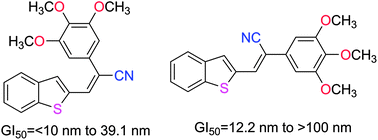Synthesis and evaluation of a series of benzothiophene acrylonitrile analogs as anticancer agents†
Abstract
A new library of small molecules with structural features resembling

* Corresponding authors
a
Department of Pharmaceutical Sciences, College of Pharmacy, University of Arkansas for Medical Sciences, Little Rock, AR 72205, USA
E-mail:
pacrooks@uams.edu
Fax: +1-501-686-6057
Tel: +1-501-686-6495
b
Department of Pharmaceutical Sciences, College of Pharmacy, University of Kentucky, Lexington, KY 40536, USA
E-mail:
mlegg2@email.uky.edu
Fax: +1-859-257-7564
Tel: +1-859-257-2633
A new library of small molecules with structural features resembling

 Please wait while we load your content...
Something went wrong. Try again?
Please wait while we load your content...
Something went wrong. Try again?
N. R. Penthala, V. N. Sonar, J. Horn, M. Leggas, J. S. K. B. Yadlapalli and P. A. Crooks, Med. Chem. Commun., 2013, 4, 1073 DOI: 10.1039/C3MD00130J
To request permission to reproduce material from this article, please go to the Copyright Clearance Center request page.
If you are an author contributing to an RSC publication, you do not need to request permission provided correct acknowledgement is given.
If you are the author of this article, you do not need to request permission to reproduce figures and diagrams provided correct acknowledgement is given. If you want to reproduce the whole article in a third-party publication (excluding your thesis/dissertation for which permission is not required) please go to the Copyright Clearance Center request page.
Read more about how to correctly acknowledge RSC content.
 Fetching data from CrossRef.
Fetching data from CrossRef.
This may take some time to load.
Loading related content
